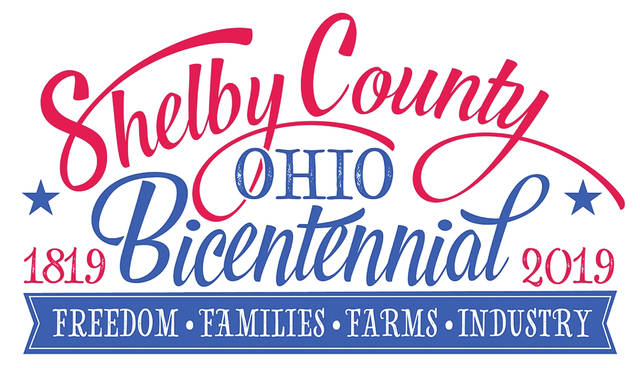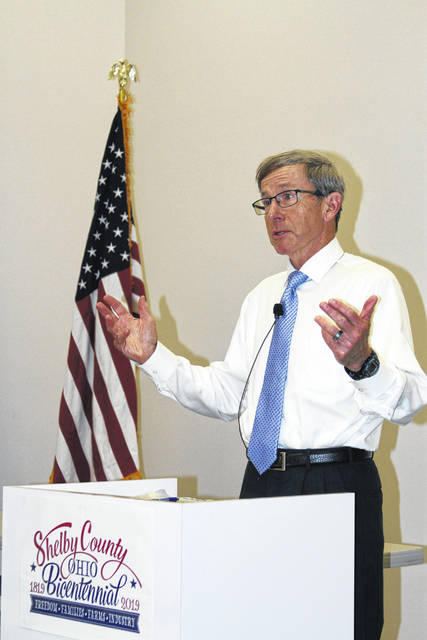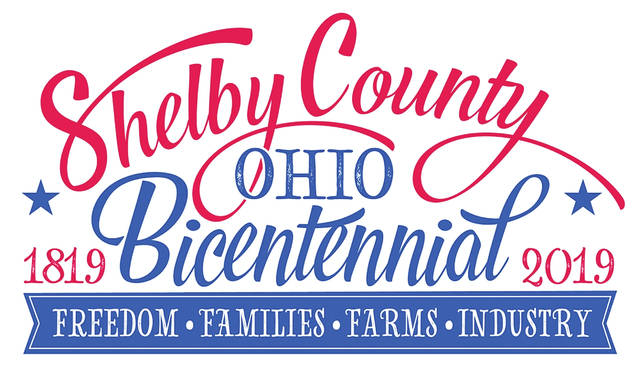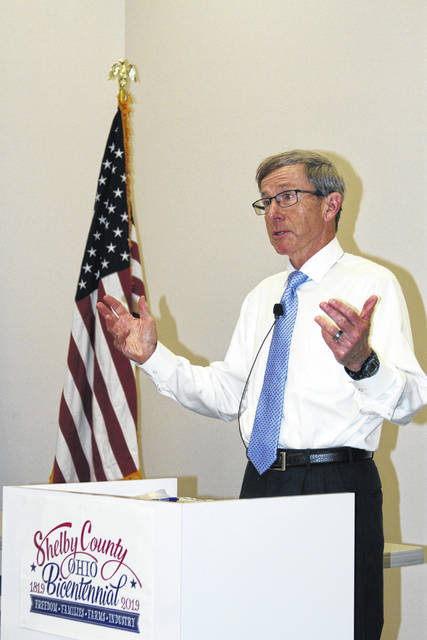



SIDNEY — Local historian Rich Wallace of Sidney kicked off the Shelby County Bicentennial lecture series Thursday night with his talk on the history Shelby County and more specifically Sidney, Ohio and why it has continued to prosper since its founding and designation as the county seat 200 years ago in 1820.
Wallace’s talk titled — “Why We Are Who We Are, A Bicentennial Retrospective” — revealed how a unique series of events combined with the selfless attitude of people living in the area contributed the growth of Sidney and Shelby County and the fruits of success residents now enjoy. Wallace gave his talk at the Amos Memorial Library in Sidney with approximately 60 peoplein attendance. He reminded those present the status Sidney now enjoys did not come by accident, but by the efforts of those who put others first.
Wallace, a local attorney and recognized authority in the realm of local history, shared a wealth of historical facts associated with the founding, growth, and exceptional characteristics that helped shape Sidney and set it apart from other cities in the rest of the United States, large and small. “We have a reason to be proud here in Sidney — from carving out a place to live in a wilderness to the development of the MRI we enjoy a legacy of some of the most significant, effective roles in in our nation’s history. Sidney has persistently set the bar that others have to meet to reach a plane of excellence,” Wallace said.
When Wallace talked about the process of gathering information for his presentation, he said he invited the opinions of several local residents holding various positions of expertise in business, government, education, and other activities; he asked what it was that put Sidney on the map.
Smiling, Wallace observed, “Some said it was the beer that was brewed here; others cited the quality of our soil, abundance of timber, gravel and other natural resources that supported activities like farming, furniture building, and materials for construction and building roads and railways. Those working in infrastructure planning, engineering, and industry said the major contributor was everything from transportation to manufacturing. And then of course the individuals working in our medical field, schools and institutes of higher learning chalked up Sidney’s growth to education. However, after I considered all that was shared with me I realized that it would still be hard to choose that one thing; that certain something that was the key factor for Sidney’s success. Then, as I dug deeper looking for that isolated feature while I studied the highlights in the history of Sidney and the surrounding county, one resource stood out as the most important: the character of our people! It was the people not the things that made us who we are today!”
While doing research Wallace disclosed he noticed an underlying element of generosity, self-sacrifice, love and respect for one’s neighbor as the foundational, recurring factor in just about every situation that had a favorable effect on the community as a whole.
“In 1810 Cephas Carey built a stockade, a place of refuge not only large enough for himself and his family, but for all the others living in the area who might need a sanctuary in times of trouble and war. Later Dr. William Fielding worked tirelessly to get a feeder canal built from Lockington to Sidney insuring a foothold on the advantages associated with being tied to the vast canal system in the northeast,” said Wallace.
“Later when it became evident the railroads would eventually be replacing the canals, local attorney Hugh Thompson helped in securing both north-south and east-west railroad lines that connected Sidney to the rest of the growing economies throughout the United States, and it didn’t stop there; our city fathers also saw to it that Sidney was the first city in Ohio to build a monument building commemorating the sacrifice of all those who died in the Civil War striving to secure ‘justice and liberty for all’ regardless of who or what we are, ” Wallace said, acknowledging the esteem held for others here and countrywide as the core characteristic shared by all.
“In all these situations none of these people considered what they stood to gain, they did what they did for the good of their neighbors, for the overall good of Sidney, the surrounding area and their country; they put community service above self,” Wallace said, noting the common denominator of “Service Sevorum” or “place the good of others first” was the thread binding the distinctive fabric of Sidney and its people.
“During World War II local business leaders like John Sexauer worked 56 hours a week at Monarch machine Tool supporting the country’s defense while running their own businesses on the side. After the war, Cecil Watkins of Sidney, spear-headed the establishment of the Tawawa Park Civic Association made up of local citizens who rallied to raise money to purchase the large tract of land we now know as Tawawa Park; and even in 1948 when sentiments for the people living in Germany was at an all-time low, local farmers in Shelby County donated over $250,000 worth of food, clothing and other goods to the people in Germany who were suffering from the effects of WWII,” said Wallace who noted that later when Germany was back on its feet, the German people presented six silver plates worldwide to those who helped them the most after the war; three of those plates went to the U.S. with one of them specifically presented to the people living in Sidney and Shelby County.
“If anyone ever tries to tell me this is just another average community, I’m not buying it,” said Wallace who mentioned Sidney received “All American City” status in 1964. “A standing that is well deserved and it was made possible by a lot of good people who thought as much about others as themselves.”
Also in his presentation Wallace shared a list of 13 local industries, “The Commercial Club,” that had a dramatic effect on forging a legacy of leadership in Sidney from the late 1800’s to the present and expressed how that quality of leadership created a contagious environment for others seeking a desirable place to build on their future. The Commercial Club included a large assortment of manufacturing facilities ranging from tanneries and buggy whip manufacturers to furniture builders, iron and aluminum foundries, and industry leaders in the machine-tooling trade like Monarch Machine Tool.
“Sidney is a ‘City of Firsts’ not only in Ohio and the US but around the world.” Wallace said. “Copeland Corporation or Emerson Inc. as we know it today, is the world leader in refrigeration and was built on donations its developers collected from people on the court square in Sidney. Wally Byam founder of Airstream Trailers Inc. chose Jackson Center in Shelby County as the international headquarters for his company based on the legacy of the people living here and others from Sidney like American chemist Paul Lauterbur who was born and raised here and went on to co-design and develop the magnetic resonance imaging process or MRI; a feat that dramatically changed the field of modern medicine and later led to his securing the Nobel Peace Prize in Medicine in 2003.”
Wallace closed his presentation again acknowledging the part selfless people played in the development of Sidney and Shelby County and said the future now rests in the hands of our youth.
“Yes the people were our greatest asset and they still are; and this story is not finished yet. When we are handed a great legacy, we are also handed a responsibility to build on it and pass it on. Now it’s up to our young leaders, and young people everywhere, this is your challenge; Sidney is a great city, let’s keep it that way,” said Wallace.



